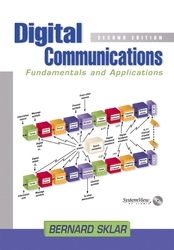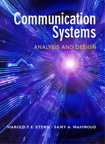Communication Systems: Fundamentals and Design Methods (Hardcover)
暫譯: 通信系統:基本原理與設計方法 (精裝版)
Nevio Benvenuto, Roberto Corvaja, Tomaso Erseghe, Nicola Laurenti
- 出版商: Wiley
- 出版日期: 2006-12-01
- 售價: $3,480
- 貴賓價: 9.5 折 $3,306
- 語言: 英文
- 頁數: 548
- 裝訂: Hardcover
- ISBN: 0470018224
- ISBN-13: 9780470018224
-
相關分類:
通訊系統 Communication-systems
海外代購書籍(需單獨結帳)
買這商品的人也買了...
-
 Digital Signal Processing (Paperback)
Digital Signal Processing (Paperback)$900$882 -
 Borland C++ Builder 6 程式設計經典
Borland C++ Builder 6 程式設計經典$580$458 -
 Visual C#.NET 程式設計經典
Visual C#.NET 程式設計經典$650$514 -
 Principles of Random Signal Analysis and Low Noise Design : The Power Spectral Density and its Applications
Principles of Random Signal Analysis and Low Noise Design : The Power Spectral Density and its Applications$890$872 -
 JSP 2.0 技術手冊
JSP 2.0 技術手冊$750$593 -
 $1,029Probability and Random Processes: With Applications to Signal Processing and Communications
$1,029Probability and Random Processes: With Applications to Signal Processing and Communications -
 深入淺出設計模式 (Head First Design Patterns)
深入淺出設計模式 (Head First Design Patterns)$880$695 -
 深入淺出 Java 程式設計, 2/e (Head First Java, 2/e)
深入淺出 Java 程式設計, 2/e (Head First Java, 2/e)$880$695 -
 LPI Linux 第一級資格檢定 (LPI Linux Certification In a Nutshell, 2/e)
LPI Linux 第一級資格檢定 (LPI Linux Certification In a Nutshell, 2/e)$880$695 -
 Java 認證 SCJP 5.0 猛虎出閘
Java 認證 SCJP 5.0 猛虎出閘$650$514 -
 ASP.NET 2.0 深度剖析範例集
ASP.NET 2.0 深度剖析範例集$650$507 -
 PHP + MySQL 快速入門
PHP + MySQL 快速入門$680$537 -
 $1,156Image Processing, Analysis, and Machine Vision, 3/e (IE-Paperback)
$1,156Image Processing, Analysis, and Machine Vision, 3/e (IE-Paperback) -
 SQL 語法範例辭典
SQL 語法範例辭典$550$468 -
 精通 MFC 視窗程式設計─Visual Studio 2005 版
精通 MFC 視窗程式設計─Visual Studio 2005 版$750$593 -
 聖殿祭司的 ASP.NET 2.0 專家技術手冊-使用VB, 2/e
聖殿祭司的 ASP.NET 2.0 專家技術手冊-使用VB, 2/e$720$569 -
 Java SE6 技術手冊
Java SE6 技術手冊$590$466 -
 Wireless Transceiver Design: Mastering the Design of Modern Wireless Equipment and Systems (Hardcover)
Wireless Transceiver Design: Mastering the Design of Modern Wireless Equipment and Systems (Hardcover)$1,560$1,529 -
 軟體測試實務講座─來自矽谷的技術經驗與心得分享
軟體測試實務講座─來自矽谷的技術經驗與心得分享$290$226 -
 現代嵌入式系統開發專案實務-菜鳥成長日誌與專案經理的私房菜
現代嵌入式系統開發專案實務-菜鳥成長日誌與專案經理的私房菜$600$480 -
 深入淺出 PMP (Head First PMP)
深入淺出 PMP (Head First PMP)$880$695 -
 PHP 網頁大作戰:如何防止駭客入侵您的網頁
PHP 網頁大作戰:如何防止駭客入侵您的網頁$420$332 -
 $399CCNA ICND2 Official Exam Certification Guide (CCNA Exams 640-816 and 640-802), 2/e
$399CCNA ICND2 Official Exam Certification Guide (CCNA Exams 640-816 and 640-802), 2/e -
 管理者的數字力─學會分析與解讀公司的經營數據
管理者的數字力─學會分析與解讀公司的經營數據$450$351 -
 最新 PHP + MySQL + AJAX 網頁程式設計
最新 PHP + MySQL + AJAX 網頁程式設計$650$553
商品描述
Description
In undergraduate classes on communications it is crucial for the students to acquire a deep and thorough understanding of the system principles, methods of analysis, and design tradeoffs. Communication Systems: Fundamentals and Design Methods provides a rigorous mathematical treatment of modulations, covering well-established analog techniques, such as AM and FM, and the more advanced digital formats, such as QAM and CDMA. Using a probabilistic approach, the analytical evaluation of system performance gives rise to the key concept of 'link budget', showing the role of transmit power, channel bandwidth and receiver noise level. Different systems are then compared on the basis of the above parameters.Key features:
Table of Contents
Preface.Acknowledgments.
Acronyms.
Symbols.
Introduction.
1 Preliminaries on deterministic and random signals.
1.1 Time and frequency domain representation.
1.1.1 Continuous time signals.
1.1.2 Frequency domain representation for periodic signals.
1.1.3 Discrete time signals.
1.2 Energy and power.
1.2.1 Energy and energy spectral density.
1.2.2 Instantaneous and average power.
1.3 Systems and transformations.
1.3.1 Properties of a system.
1.3.2 Filters.
1.3.3 Sampling.
1.3.4 Interpolation.
1.4 Bandwidth.
1.4.1 Classification of signals and systems.
1.4.2 Uncertainty principle.
1.4.3 Practical definitions of band.
1.4.4 Heaviside conditions.
1.4.5 Sampling theorem.
1.4.6 Nyquist criterion.
1.5 Representation of passband signals.
1.5.1 Analytic signal.
1.5.2 Baseband equivalent.
1.5.3 Baseband equivalent of a transformation.
1.5.4 Hilbert transform.
1.5.5 Envelope, instantaneous phase and frequency.
1.6 Random variables and vectors.
1.6.1 Statistical description of random variables.
1.6.2 Expectation and statistical power.
1.6.3 Random vectors.
1.6.4 Second order description of random vectors and Gaussian vectors.
1.6.5 Complex-valued random variables.
1.7 Random processes.
1.7.1 Definition and properties.
1.7.2 Stationary and ergodic random processes.
1.7.3 Second order description of a WSS process.
1.7.4 Joint second order description of two random processes.
1.7.5 Second order description of a cyclostationary process.
1.8 Systems with random inputs and outputs.
1.8.1 Filtering of a WSS random process.
1.8.2 Filtering of a cyclostationary random process.
1.8.3 Representation of passband WSS random processes.
1.8.4 Sampling and interpolation of stationary random processes.
Appendix: The complementary normalized Gaussian distribution function.
References.
Problems.
2 Characterization of transmission media and devices.
2.1 Two-terminal devices.
2.1.1 Device representation.
2.1.2 Electrical power.
2.1.3 Measurement of electrical power.
2.1.4 Load matching and available power.
2.1.5 Thermal noise.
2.1.6 Other sources of noise.
2.1.7 Noise temperature.
2.1.8 Equivalent noise models.
2.2 Two-port networks.
2.2.1 Reference model.
2.2.2 Network power gain and matched network.
2.2.3 Power gain in terms of electrical parameters.
2.2.4 Noise temperature.
2.2.5 Noise figure.
2.2.6 Cascade of two-port networks.
2.2.7 Signal-to-noise ratio.
2.3 Transmission system model.
2.3.1 Electrical model.
2.3.2 Transmission system model.
2.3.3 Signal-to-noise ratio.
2.3.4 Narrowband channel model.
2.3.5 Link budget.
2.4 Transmission media.
2.4.1 Transmission lines and cables.
2.4.2 Optical fibers.
2.4.3 Radio links.
References.
Problems.
3 Analog modulation systems.
3.1 Principle and System Model.
3.2 Linear modulation.
3.2.1 Double side band suppressed carrier (DSB-SC).
3.2.2 Single side band modulation (SSB).
3.2.3 Vestigial side band modulation (VSB).
3.2.4 Quadrature modulation (QM).
3.2.5 Implementation issues.
3.2.6 Performance measure and reference SNR.
3.2.7 Performance evaluation.
3.3 Amplitude modulation (AM).
3.3.1 Parameters.
3.3.2 Implementation issues.
3.3.3 Carrier recovery.
3.3.4 Performance evaluation.
3.4 Phase locked loop (PLL).
3.5 Angular modulation.
3.5.1 Phase and frequency modulations.
3.5.2 Bandwidth.
3.5.3 Narrowband and wideband FM.
3.5.4 Demodulation.
3.5.5 Implementation issues.
3.5.6 Performance evaluation.
3.5.7 Pre-emphasis and de-emphasis in FM.
3.6 Comparison of analog modulation systems.
3.7 Frequency division multiplexing. multiple access.
3.8 Super-heterodyne receiver.
3.9 Examples of application.
3.9.1 AM radio.
3.9.2 FM radio.
3.9.3 FM stereo radio.
3.9.4 Television signal.
References.
Problems.
4 Digital modulation systems.
4.1 The space of signals.
4.1.1 Linear space.
4.1.2 Signals as elements in a linear space.
4.1.3 Gram-Schmidt orthonormalization in signal spaces.
4.1.4 Vector representation of signals.
4.1.5 Orthogonal projections onto a signal space.
4.2 Digital modulation theory.
4.2.1 Optimum detection in additive noise channels.
4.2.2 Statistical characterization of random vectors.
4.2.3 Optimum decision regions.
4.2.4 Maximum a posteriori criterion.
4.2.5 Maximum likelihood criterion.
4.2.6 Minimum distance criterion.
4.2.7 Implementation of minimum distance receivers.
4.2.8 The theorem of irrelevance.
4.3 Binary modulation.
4.3.1 Error probability.
4.3.2 Antipodal and orthogonal signals.
4.3.3 Single filter receivers.
4.4 M-ary modulation.
4.4.1 Bounds on the error probability.
4.4.2 Orthogonal and bi-orthogonal modulations.
4.5 The digital modulation system.
4.5.1 System overview.
4.5.2 Front-end receiver implementation.
4.5.3 The binary channel.
4.5.4 The inner numerical channel.
4.6 Examples of digital modulations.
4.6.1 Pulse amplitude modulation (PAM).
4.6.2 Quadrature amplitude modulation (QAM).
4.6.3 Phase shift keying (PSK).
4.6.4 Frequency shift keying (FSK).
4.6.5 Code division modulation.
4.7 Comparison of digital modulation systems.
4.7.1 Reference bandwidth and link budget.
4.7.2 Comparison in terms of performance, bandwidth and spectral efficiency.
References.
Problems.
5 Digital transmission of analog signals.
5.1 Digital representation of waveforms.
5.1.1 Analog to digital converter (ADC).
5.1.2 Digital to analog converter (DAC).
5.1.3 Quantizer.
5.1.4 Uniform quantizers.
5.1.5 Quantization error.
5.1.6 SNR of a quantizer.
5.1.7 Non-uniform quantizers.
5.1.8 Companding techniques and SNR.
5.2 Digital transmission of analog signals.
5.2.1 Transmission through a binary channel.
5.2.2 Evaluation of the overall SNR.
5.2.3 Analog versus digital transmission.
5.2.4 Regenerative and analog repeaters.
5.3 Time division multiplexing (TDM).
5.4 Examples of application.
References.
Problems.
6 Transmission over dispersive channels.
6.1 Channel model.
6.2 Baseband digital transmission (PAM systems).
6.3 Passband digital transmission (QAM systems).
6.3.1 Baseband equivalent of QAM systems.
6.4 Analysis of amplitude modulated systems.
6.4.1 Signals.
6.4.2 PSD of noise.
6.4.3 PSD of digital modulated signals.
6.5 Intersymbol interference.
6.5.1 Nyquist pulses.
6.5.2 Eye diagram.
6.6 Performance analysis.
6.6.1 Symbol error probability in the absence of ISI.
6.6.2 Symbol error probability in the presence of ISI.
6.7 Application examples.
6.7.1 Line codes.
6.7.2 Transmission formats.
6.7.3 Channel.
6.7.4 Equalization.
References.
Problems.
7 Elements of Information Theory, Source and Channel Coding.
7.1 Information and entropy.
7.1.1 A measure for information.
7.1.2 Entropy.
7.1.3 Efficiency and redundancy.
7.1.4 Information rate of a message.
7.1.5 Typical sequences.
7.2 Source coding.
7.2.1 The purpose of source coding.
7.2.2 Entropy coding.
7.2.3 Shannon theorem on source coding.
7.2.4 Huffman coding.
7.2.5 Arithmetic coding.
7.3 Channel coding.
7.3.1 The purpose of channel coding.
7.3.2 Binary block codes.
7.3.3 Decoding criteria. Minimum distance decoding.
7.3.4 Linear codes.
7.3.5 Cyclic codes.
7.3.6 Application of channel codes.
7.4 Channel capacity.
7.4.1 Information rate and capacity of a numerical channel.
7.4.2 Capacity of the additive white Gaussian noise (AWGN) channel.
7.4.3 Shannon theorem on channel coding.
References.
Problems.
Topic Index.
商品描述(中文翻譯)
描述
在本科的通訊課程中,學生必須深入了解系統原理、分析方法和設計權衡。 《通信系統:基本原理與設計方法》對調變進行了嚴謹的數學處理,涵蓋了成熟的類比技術,如AM和FM,以及更先進的數位格式,如QAM和CDMA。通過概率方法,系統性能的分析評估引出了“鏈路預算”的關鍵概念,顯示了發射功率、通道帶寬和接收器噪聲水平的作用。然後根據上述參數比較不同的系統。
主要特點:
- 全面涵蓋通信系統的基本知識,而不過度強調需要更深背景的新技術。
- 提供清晰的課程大綱,源自多年的教學經驗。
- 通過討論和實施示例,以及近300個問題的多樣性進行豐富,解答可在伴隨網站上找到。
- 包括確定性和隨機信號的覆蓋,以及傳輸媒介和設備、通帶信號、線性、幅度、角度、數位和二進制調變。
本書是電機工程、計算機科學和電信課程本科生的完美教科書,亦適合參與通信網絡設計和部署的研究生、工程師和操作員。
目錄
前言
致謝
縮寫詞
符號
引言
1 確定性和隨機信號的初步知識
1.1 時域和頻域表示
1.1.1 連續時間信號
1.1.2 週期信號的頻域表示
1.1.3 離散時間信號
1.2 能量和功率
1.2.1 能量和能量譜密度
1.2.2 瞬時功率和平均功率
1.3 系統和變換
1.3.1 系統的特性
1.3.2 濾波器
1.3.3 取樣
1.3.4 插值
1.4 帶寬
1.4.1 信號和系統的分類
1.4.2 不確定性原理
1.4.3 帶的實用定義
1.4.4 赫維賽德條件
1.4.5 取樣定理
1.4.6 奈奎斯特準則
1.5 通帶信號的表示
1.5.1 解析信號
1.5.2 基帶等效
1.5.3 變換的基帶等效
1.5.4 希爾伯特變換
1.5.5 包絡、瞬時相位和頻率
1.6 隨機變量和向量
1.6.1 隨機變量的統計描述
1.6.2 期望值和統計功率
1.6.3 隨機向量
1.6.4 隨機向量和高斯向量的二階描述
1.6.5 複值隨機變量
1.7 隨機過程



























